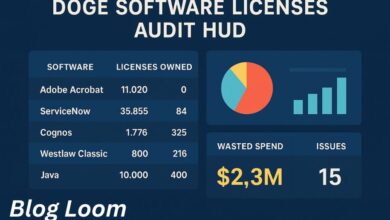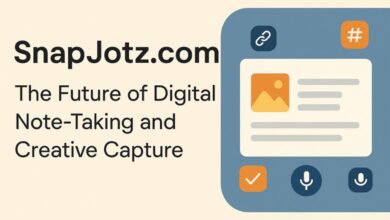Plftiger: The Complete Guide to the Next-Gen Digital Framework

In the rapidly expanding universe of digital systems, automation frameworks, and AI-driven tools, certain keywords start small and then suddenly become industry talking points. One such unusual yet increasingly visible keyword is “plftiger.” On the surface, it looks like a simple coined term. But the deeper you explore, the clearer it becomes that plftiger represents a growing technological movement rather than a single product or framework.
Across blogs, discussions, technical explainers, and cybersecurity think pieces, plftiger appears as a flexible conceptual model used to explain hybrid project ecosystems, AI automation platforms, emerging digital governance structures, and even next-generation cybersecurity architecture.
This article digs deeply — and I mean deeply — into the world of plftiger: what it means, why it’s trending, where it’s heading, and how industries might adopt it. Whether you’re researching the term for SEO reasons, preparing content for a tech publication, or simply curious about its potential impact, this comprehensive guide will give you everything you need.
Let’s unpack plftiger from every angle.
What Exactly Is Plftiger?
The truth is, plftiger isn’t a single fixed definition. Instead, it functions as a multi-disciplinary digital concept used to describe:
• A project-lifecycle framework
• A cross-platform automation ecosystem
• An AI-driven orchestration layer
• A unified cybersecurity model
• A smart digital architecture for future-proof systems
Think of plftiger as a new category of digital thinking — the merging of different technological layers into one interconnected model. As modern software becomes more modular, decentralized, and intelligent, traditional frameworks struggle to keep up. Plftiger has grown in popularity because it represents an alternative mindset for managing this complexity.
Origins of the Plftiger Concept
While the exact origin of plftiger is difficult to trace, several interpretations across tech communities point toward a common foundation:
A. The Lifecycle Theory
Some experts use plftiger as a shorthand for a Project Lifecycle Framework for Tactical, Iterative, Goal-Driven Execution and Reporting — basically a hybrid methodology combining:
-
Waterfall planning
-
Agile responsiveness
-
DevOps deployment
-
Data-driven decision loops
This makes it appealing to businesses seeking structured flexibility.
B. The Automation & AI Perspective
Another group of analysts connects plftiger with full-stack automation systems driven by:
-
Machine learning
-
Data synthesis
-
Predictive analytics
-
Workflow automation
This view treats plftiger as an end-to-end digital nervous system for modern organizations.
C. The Cybersecurity Interpretation
Cybersecurity writers tend to frame plftiger as:
-
An AI-powered cybersecurity model
-
A unified digital shield across networks
-
A potential quantum-safe security architecture
-
A convergence of analytics, threat intelligence, and encrypted protocols
This version appeals to enterprise IT teams preparing for future digital threats.
D. The Smart Platform / Ecosystem View
Some blogs describe plftiger as an umbrella ecosystem where:
-
Blockchain
-
AI models
-
Cloud infrastructure
-
Predictive engines
-
Automation modules
-
DevOps pipelines
…all live under one strategic operational layer.
Why the Keyword Is Trending
Plftiger has exploded in tech discussions for three major reasons:
A. The Digital Industry Needs New Terminology
Tech evolves faster than vocabulary. Terms like “platform,” “cloud,” and “AI automation” now have dozens of overlapping meanings.
Plftiger gives writers and engineers a new, flexible label that fits emerging hybrid systems.
B. Blended Technology Is the Future
Businesses no longer use standalone tools. They use networks of:
-
Microservices
-
AI modules
-
Data processors
-
Monitoring systems
-
Automation engines
Plftiger captures this blend, making it an attractive phrase for describing integrated digital systems.
C. SEO and Thought Leadership
Many blogs adopt the term because:
-
It’s unique
-
It’s not overly saturated
-
It invites fresh content creation
-
It positions writers as early adopters of tech language
As more people publish exploratory content about plftiger, the keyword continues to grow.
The Pillars of the Plftiger Framework
Let’s break down the major structural components commonly associated with plftiger.
A. Intelligence Layer (AI & Analytics)
Plftiger systems aim to be self-aware, meaning they contain:
-
Predictive analytics
-
Behavior detection
-
AI recommendation engines
-
Pattern recognition models
-
Automated decision support
This layer enables systems to adapt dynamically, making plftiger tools more resilient.
B. Automation Layer
This includes:
-
Workflow automation
-
AI-powered routing
-
Multi-system orchestration
-
Real-time triggers and alerts
-
Automated reporting dashboards
A plftiger system is expected to manage complexity automatically, removing human bottlenecks.
C. Security Layer
Security-centric plftiger models emphasize:
-
Real-time threat monitoring
-
AI anomaly detection
-
Quantum-safe encryption
-
Blockchain-enabled trust networks
-
Continuous vulnerability assessment
The idea is to create a self-protecting system, not just a secure one.
D. Connectivity Layer
This is where all the digital parts interlock:
-
APIs
-
Microservices
-
Cloud environments
-
Data pipelines
-
DevOps frameworks
Plftiger supports the idea of systems that can talk to each other seamlessly, with minimal integration overhead.
E. Governance Layer
A plftiger ecosystem values:
-
Transparency
-
Traceability
-
Ethical AI usage
-
Responsible data processing
-
Regulatory compliance
This layer makes plftiger fit for industries like healthcare, finance, and government.
How Plftiger Fits Into Modern Project Management
One of the most popular interpretations of plftiger is as a hybrid project lifecycle system.
In traditional environments:
-
Waterfall = structure but slow
-
Agile = fast but chaotic
-
DevOps = operational but technical
-
AI analytics = accurate but complex
Plftiger tries to combine the advantages of all four.
A typical plftiger project flow might include:
-
High-level roadmap (Waterfall style)
-
Sprint-based execution (Agile)
-
Continuous delivery (DevOps)
-
Real-time feedback (AI/ML analytics)
This allows teams to stay structured while still being adaptive.
Plftiger in Cybersecurity
This is one of the most powerful lenses through which plftiger is viewed.
A. Intelligent Threat Detection
Under this view, plftiger integrates:
-
AI-based intrusion monitoring
-
Traffic pattern analysis
-
Behavioral anomaly detection
-
Automated risk scoring
B. Quantum-Safe Readiness
Some cybersecurity thinkers associate plftiger with the need for:
-
Quantum-resistant encryption
-
Upgraded cryptographic protocols
-
Post-quantum readiness frameworks
C. Blockchain as a Trust Layer
In some interpretations, plftiger includes a smart blockchain audit layer for:
-
Secure distributed logs
-
Tamper-proof governance
-
Decentralized verification
D. Unified Cyber Defense
Rather than isolated tools, plftiger encourages:
-
Converged security
-
Unified dashboards
-
Centralized oversight
-
AI-driven remediation
This aligns with the modern need for integrated protection across cloud, mobile, and operational systems.
Plftiger in AI and Digital Automation
AI is where plftiger becomes especially exciting.
Use cases include:
1. Autonomous Workflow Engines
Systems make decisions without human approval.
2. Context-Aware Automation
Processes adapt based on environment and user behavior.
3. Predictive Machine Intelligence
Systems act before a problem emerges.
4. Multi-Platform Orchestration
Different software tools become one synchronized ecosystem.
5. Smart Resource Allocation
AI decides:
-
What to prioritize
-
When to scale
-
How to optimize workloads
In effect, plftiger functions as a universal conductor of digital operations.
Real-World Applications Across Industries
Plftiger concepts fit naturally into several sectors:
A. Financial Services
-
Fraud detection
-
Automated compliance
-
Secure asset monitoring
-
AI-guided investment engines
B. Healthcare
-
Patient data security
-
Predictive diagnosis tools
-
Automated triage systems
-
Digital treatment pathways
C. Software & Tech
-
DevOps workflows
-
CI/CD automation
-
Microservices orchestration
-
Performance dashboards
D. Government & Defence
-
Secure communication
-
Threat intelligence
-
Encrypted data governance
-
AI-powered operations oversight
E. E-Commerce
-
Recommendation engines
-
Automated logistics
-
Customer behavior analytics
-
Fraud prevention layers
The Aviation Angle of Plftiger
An interesting, unexpected side narrative connects plftiger to aviation innovation.
Some niche blogs reference plftiger as:
-
A call sign or operational identifier
-
A conceptual framework for lightweight aircraft design
-
A strategic model for autonomous flight systems
In these contexts, plftiger is tied to:
-
Smart aerodynamics
-
AI flight assistance
-
Low-emission propulsion
-
Safety automation
While this interpretation isn’t mainstream, it adds depth to the keyword’s evolution.
Challenges, Limitations, and Misconceptions
No conversation about plftiger is complete without looking at the downsides.
A. Over-Generalization
Because plftiger is flexible, some misuse it as a catch-all term.
B. Conceptual Ambiguity
Without a single official definition, its meaning shifts by context — confusing beginners.
C. Implementation Gaps
Companies may adopt the term without adopting real structural change.
D. Security Risks if Misconfigured
Plftiger’s integrated nature means:
-
A single flaw may affect all systems
-
Automation errors can propagate quickly
E. Over-Hype
Some articles oversell plftiger as a “magic solution.”
It’s powerful — but not miraculous.
The Future of Plftiger
The future of plftiger looks promising in several areas:
1. Unified Enterprise Platforms
Businesses are shifting toward stackless systems, and plftiger aligns perfectly with this vision.
2. Intelligent Autonomous Networks
Self-monitoring, self-healing, and self-optimizing digital ecosystems will continue to grow.
3. AI Governance Models
As AI becomes regulated globally, plftiger frameworks may guide compliance.
4. Advanced Data Orchestration
We’re moving toward a world where data flows freely across clouds, tools, and devices.
Plftiger is the type of concept that fits this future.
5. Quantum-Era Cybersecurity
With advancements in quantum computing, plftiger-style security layers may become standard.
Final Thoughts
Plftiger represents a new wave of digital thinking — a flexible conceptual structure uniting AI, automation, security, governance, and platform engineering. It’s a forward-looking keyword that fits the direction of modern technology: integrated, intelligent, automated, and adaptive.
As more creators, developers, strategists, and technology thinkers adopt the plftiger mindset, the keyword will likely grow beyond theory into full-scale frameworks, real products, and enterprise-level models.
And as always, if you’re exploring technology trends, deep-dive concepts, or digital frameworks, you’ll continue to find detailed coverage and insights on Blog Loom, where we make complex tech easy to understand and accessible for everyone.
Thanks for reading — and stay tuned for more future-tech explorations right here on Blog Loom.
You may also read: Namiszovid: The Post-Pandemic Digital Revolution Redefining Innovation




